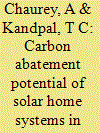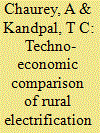| Srl | Item |
| 1 |
ID:
088032


|
|
|
|
|
| Publication |
2009.
|
| Summary/Abstract |
About 78 million rural households in India reportedly lack access to grid electricity. About 67 million of them use kerosene for lighting. Government of India is promoting the use of solar home systems (SHS) as one of the options for meeting lighting requirements in households in remote and less inhabited villages. About 363,399 SHS were reportedly disseminated across the country by December 2007. Apart from meeting the basic lighting need of the households, SHS also help in abating the emissions of green house gases (GHGs) by directly displacing the use of kerosene in households that currently use it for lighting. This study has attempted at estimating the CO2 mitigation potential of SHS in India by studying the potential for their diffusion and the appropriate baseline. Subsequently, the scope for cost reduction to the user due to carbon finance, if received, is also studied. It is found that carbon finance could reduce the effective burden of SHS to the user by 19% if carbon prices were $10/tCO2 and no transaction costs were involved in getting the carbon revenues. These benefits are also estimated for scenarios where transaction costs are incurred by the project proponent in getting the carbon benefits.
|
|
|
|
|
|
|
|
|
|
|
|
|
|
|
|
| 2 |
ID:
092830


|
|
|
|
|
| Publication |
2009.
|
| Summary/Abstract |
About 68 million households in India rely on kerosene as a fuel for domestic lighting. Kerosene-based lighting devices, not only for poor quality of light, but also for the risks of indoor air pollution and fire hazards, etc. are not a desired option for domestic lighting purposes. Solar lantern is a better alternative in terms of its quality of illumination, durability and versatility of use. The dissemination model for solar lantern in India has so far been based on cash sales with or without the incentive of capital subsidy. This paper analyses several dissemination models including rental and fee-for-service based on centralized solar charging station concept for CFL- and LED-based designs of solar lanterns available in India. The basis of comparison is the acceptable daily costs or rental to the user as well as to the owner of the charging station. Further, the paper studies the impact of likely escalation in kerosene price on the acceptable daily rental and estimates the amount of subsidy required to make the charging station model viable for disseminating solar lanterns among rural households.
|
|
|
|
|
|
|
|
|
|
|
|
|
|
|
|
| 3 |
ID:
096152


|
|
|
|
|
| Publication |
2010.
|
| Summary/Abstract |
Solar home systems are typically used for providing basic electricity services to rural households that are not connected to electric grid. Off-grid PV power plants with their own distribution network (micro/minigrids) are also being considered for rural electrification. A techno-economic comparison of the two options to facilitate a choice between them is presented in this study on the basis of annualised life cycle costs (ALCC) for same type of loads and load patterns for varying number of households and varying length and costs of distribution network. The results highlight that microgrid is generally a more economic option for a village having a flat geographic terrain and more than 500 densely located households using 3-4 low power appliances (e.g. 9 W CFLs) for an average of 4 h daily. The study analyses the viability of the two options from the perspectives of the user, an energy service company and the society.
|
|
|
|
|
|
|
|
|
|
|
|
|
|
|
|